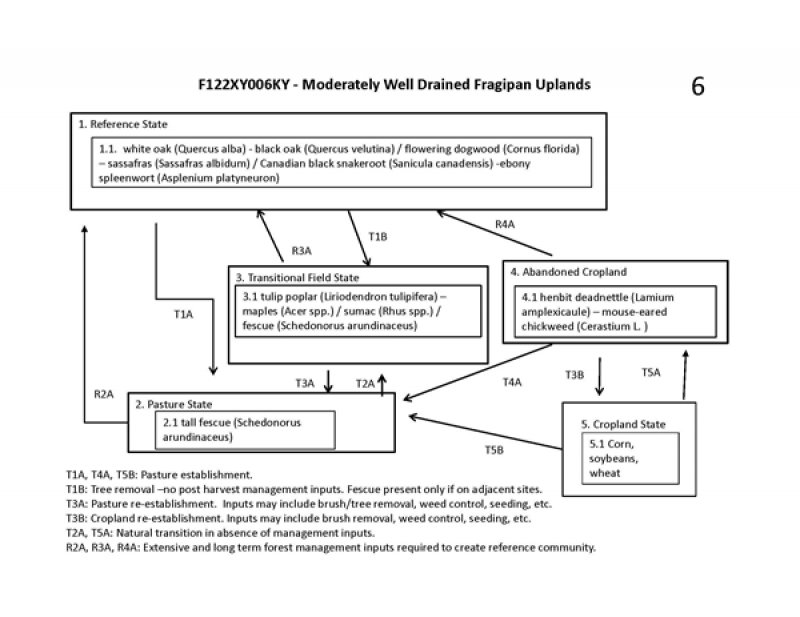
Natural Resources
Conservation Service
Ecological site F122XY006KY
Moderately Well Drained Fragipan Uplands
Last updated: 5/14/2025
Accessed: 12/22/2025
General information
Provisional. A provisional ecological site description has undergone quality control and quality assurance review. It contains a working state and transition model and enough information to identify the ecological site.
MLRA notes
Major Land Resource Area (MLRA): 122X–Highland Rim and Pennyroyal
MLRA 122 is in Tennessee (47 percent), Kentucky (43 percent), Indiana (7 percent), and Alabama (3 percent). It makes up about 21,530 square miles (55,790 square kilometers).
SOILS:
Many of the soils in this MLRA are Udalfs. The moderately deep to very deep, well drained, clayey soils formed in limestone residuum. They are dominantly in rolling to steep areas of the “Outer Basin” (Mimosa, Braxton, Gladdice, and Hampshire series) and the undulating to hilly areas of the “Inner Basin” (Talbott and Bradyville series). The most agriculturally productive soils are the very deep, well drained, clayey or loamy soils that formed in alluvium and/or loess over alluvium or limestone residuum in nearly level to undulating areas (Armour, Cumberland, Harpeth, Lomond, and Maury series). The less extensive soils generally are moderately well drained to somewhat poorly drained and formed in loamy or clayey alluvium and/or residuum (Byler, Capshaw, Colbert, and Tupelo series). This MLRA has a significant acreage of Mollisols. Shallow or moderately deep, well drained, clayey Udolls (Ashwood and Barfield series) formed in limestone residuum dominantly in rolling to steep areas. Very shallow, well drained, clayey Rendolls (Gladeville series) formed in limestone residuum dominantly in undulating to rolling areas of the “Inner Basin.” Very deep, well drained or moderately well drained Udolls (Arrington, Egam, Lynnville, and Staser series) and somewhat poorly drained or poorly drained Aquolls (Agee, Godwin, and Lanton series) formed in loamy or clayey alluvium derived from limestone on flood plains. Most of the remaining soils on flood plains are moderately well drained or well drained Udepts (Lindell and Ocana series). Udults are of small extent in this area. Most are very deep, well drained, and loamy and formed in gravelly colluvium or colluvium and the underlying residuum on steep hillsides (Dellrose soils). Rock outcrops are common on uplands.
BIOLOGICAL RESOURCES:
This area supports mixed oak forest vegetation. White oak, black oak, northern red oak, and some scarlet oak are the dominant tree species. Shagbark hickory, bitternut hickory, pignut hickory, and mockernut hickory also occur. Oak, blackgum, flowering dogwood, sassafras, Virginia pine, pitch pine, and shortleaf pine grow mostly on ridgetops.
(Excerpt from United States Department of Agriculture, Natural Resources Conservation Service. 2006. Land Resource Regions and Major Land Resource Areas of the United States, the Caribbean, and the Pacific Basin. U.S. Department of Agriculture Handbook 296.)
Classification relationships
Scientific Name: Southern Interior Low Plateau Dry-Mesic Oak Forest, Unique Identifier: CES202.898
Field work is required to better evaluate the exact community composition of these sites. The sites visited showed great variation in species composition.
Ecological site concept
6-Moderately Well-Drained Fragipan Uplands
MLRA 122
Ecological Dynamics:
This PES describes hypotheses based on available data of many different scales and sources. This PES also does not encompass the entire complexity or diversity of these sites. Additional field studies would be required for conservation planning purposes or to develop a comprehensive and science-based restoration plan for these sites.
Ecological Dynamics
This PES describes a forest community on very deep, moderately well-drained soils with a fragipan layer between 20-40 inches deep. The range of variation in plant composition on these sites vary mainly due to soil depth, available water, management, disturbance history, and in some cases, aspect. Actual field work is required to develop a full ecological site description (ESD), a field-based state and transition model, and accurate plant community phases to support future conservation planning.
Most areas of these soils are used to grow corn, soybeans, wheat and hay. Some areas are used for permanent pasture, and only a few of these areas are still in native forest.
State 1. (Reference)
Phase 1.1: White oak (Quercus alba) - black oak (Quercus velutina) / flowering dogwood (Cornus florida) – sassafras (Sassafras albidum) / Canadian black snakeroot (Sanicula canadensis) - ebony spleenwort (Asplenium platyneuron).
NASIS trees-on-site data showed a great deal of variation in tree dominance. The oak component will vary depending on slope, topography, previous and on-going disturbances, moisture, and seed sources. Oaks and hickories documented on these soils in NASIS include: white oak, black oak, cherrybark oak, hybrid hickory, and northern red oak. Other trees recorded in NASIS for these sites include tulip poplar, white ash, sweetgum, sugar maple and American beech. These are likely successional forest stages which would consist of shade tolerant, fast growing species.
The understory communities are variable depending on management, disturbances, topography, and seed sources. Sites may include agrimony, bedstraws, snakeroots, Virginia creeper, spleenworts, and Solomon's seal. The shrub layer likely includes dogwood, sassafras, hophornbeam, and northern spicebush. In wetter areas, paw paw may be present.
Additional State and Phase information is in the Community Phase Data Section.
Associated sites
| F122XY005KY |
Moderately Deep Well Drained Uplands Moderately Deep Well Drained Uplands |
|---|
Similar sites
| F122XY010KY |
Moderately Well Drained Fragipan Terraces Moderately Well Drained Fragipan Terraces |
|---|
Table 1. Dominant plant species
| Tree |
(1) Quercus alba |
|---|---|
| Shrub |
(1) Cornus florida |
| Herbaceous |
(1) Sanicula canadensis |
Click on box and path labels to scroll to the respective text.
